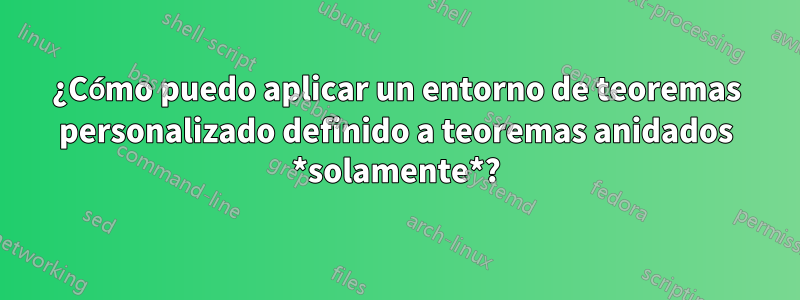
Enun hilo anterior, pregunté sobre la posibilidad de definir un entorno de teorema personalizado cuyo símbolo QED sería una versión en caja del nombre/número/etiqueta del teorema. Allí, amablemente me proporcionaron la siguiente solución:
\documentclass{book}
\usepackage{amsthm,xpatch}
\makeatletter
\let\qed@empty\openbox % <--- change here, if desired
\def\@begintheorem#1#2[#3]{%
\deferred@thm@head{%
\the\thm@headfont\thm@indent
\@ifempty{#1}
{\let\thmname\@gobble}
{\let\thmname\@iden}%
\@ifempty{#2}
{\let\thmnumber\@gobble\global\let\qed@current\qed@empty}
{\let\thmnumber\@iden\xdef\qed@current{#2}}%
\@ifempty{#3}
{\let\thmnote\@gobble}
{\let\thmnote\@iden}%
\thm@swap\swappedhead
\thmhead{#1}{#2}{#3}%
\the\thm@headpunct\thmheadnl\hskip\thm@headsep
}\ignorespaces
}
\renewcommand{\qedsymbol}{%
\ifx\qed@thiscurrent\qed@empty
\qed@empty
\else
\fbox{\scriptsize\qed@thiscurrent}%
\fi
}
\renewcommand{\proofname}{%
Proof%
\ifx\qed@thiscurrent\qed@empty
\else
\ of \qed@thiscurrent
\fi
}
\xpretocmd{\proof}{\let\qed@thiscurrent\qed@current}{}{}
\newenvironment{proof*}[1]
{\def\qed@thiscurrent{\ref{#1}}\proof}
{\endproof}
\makeatother
\newtheorem{thm}{Theorem}[section]
\newtheorem{lem}[thm]{Lemma}
\newtheorem*{nthm}{Theorem}
\begin{document}
\chapter{Title}
\section{Title}
\begin{thm}
Pigs can fly.
\end{thm}
\begin{proof}
Would you doubt it?
\end{proof}
\begin{nthm}
Unnumbered.
\end{nthm}
\begin{proof}
What should we say?
\end{proof}
The following theorem will be proved later.
\begin{thm}\label{thm:later}
$P=NP$.
\end{thm}
Long text here.
\begin{proof*}{thm:later}
Oh, well! Should I really do it? We'll use the following lemma.
\begin{lem}
Something surely can fly.
\end{lem}
\begin{proof}
Clear.
\end{proof}
Now use the lemma and apply the well known identity
\[
1=0.\qedhere
\]
\end{proof*}
\end{document}
El resultado de ese código es el siguiente:

¿Es posible modificar el código dado de tal manera que "detecte anidamiento", es decir, de modo que los teoremas/lemas/proposiciones en el "nivel superior" (no anidados) mantengan su símbolo QED habitual mientras que los teoremas/lemas/proposiciones en los niveles posteriores (aquellos que están anidados en los de nivel superior) se designan como tales con símbolos QED, ¿cuáles son los nombres/números/etiquetas en cuadros de los teoremas/lemas/proposiciones?
Aparte del código anterior, no tengo un MWE porque literalmente no tengo idea de cómo codificar algo así. Encontré un par de foros más en TeX.SX (aquíyaquí) que se ocupan del formato de entornos anidados, pero nunca pude adaptar el código que tengo al código proporcionado allí.
Cualquier ayuda sería muy apreciada.
Respuesta1
La idea es agregar un condicional que sea verdadero cuando comienza una prueba y cambiar el código en consecuencia: si el condicional es falso, no estamos anidando, por lo que lo configuramos \qed@currenten \qed@empty; de lo contrario, usamos el mismo mecanismo que en la otra respuesta.
\documentclass{book}
\usepackage{amsthm,xpatch}
\makeatletter
\let\qed@empty\openbox % <--- change here, if desired
\def\@begintheorem#1#2[#3]{%
\deferred@thm@head{%
\the\thm@headfont\thm@indent
\@ifempty{#1}
{\let\thmname\@gobble}
{\let\thmname\@iden}%
\@ifempty{#2}
{\let\thmnumber\@gobble\global\let\qed@current\qed@empty}
{\let\thmnumber\@iden
\ifqed@inproof
\xdef\qed@current{#2}%
\else
\global\let\qed@current\qed@empty
\fi}%
\@ifempty{#3}
{\let\thmnote\@gobble}
{\let\thmnote\@iden}%
\thm@swap\swappedhead
\thmhead{#1}{#2}{#3}%
\the\thm@headpunct\thmheadnl\hskip\thm@headsep
}\ignorespaces
}
\renewcommand{\qedsymbol}{%
\ifx\qed@thiscurrent\qed@empty
\qed@empty
\else
\fbox{\scriptsize\protect\qed@thiscurrent}%
\fi
}
\renewcommand{\proofname}{%
Proof%
\ifx\qed@thiscurrent\qed@empty
\else
\ of \qed@thiscurrent
\fi
}
\newif\ifqed@inproof
\xpretocmd{\proof}{\let\qed@thiscurrent\qed@current\qed@inprooftrue}{}{}
\newenvironment{proof*}[1]
{\def\qed@thiscurrent{\ref{#1}}\proof}
{\endproof}
\def\debug{\show\qed@thiscurrent}
\makeatother
\newtheorem{thm}{Theorem}[section]
\newtheorem{lem}[thm]{Lemma}
\newtheorem*{nthm}{Theorem}
\begin{document}
\chapter{Title}
\section{Title}
\begin{thm}
Pigs can fly.
\end{thm}
\begin{proof}
Would you doubt it?
\end{proof}
\begin{nthm}
Unnumbered.
\end{nthm}
\begin{proof}
What should we say?
\end{proof}
The following theorem will be proved later.
\begin{thm}\label{thm:later}
$P=NP$.
\end{thm}
Long text here.
\begin{proof*}{thm:later}
Oh, well! Should I really do it? We'll use the following lemma.
\begin{lem}
Something surely can fly.
\end{lem}
\begin{proof}
Clear.
\end{proof}
Now use the lemma and apply the well known identity
\[
1=0.\qedhere
\]
\end{proof*}
\end{document}



